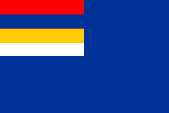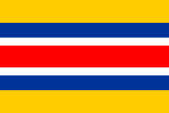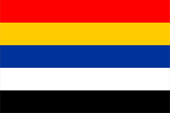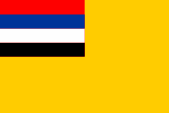|
|
| Übersicht – Contents: | |
Diese Seite ist Teil des Projektes
|
|
| Übersicht – Contents: | |
Flaggen – Flags: |
|
 |
1936–1937, Nationalflagge – national flag, Quelle/Source, nach/by: World Statesmen |
 |
1937–1939, Nationalflagge – national flag, Quelle/Source, nach/by: World Statesmen |
 |
1939–1945, Nationalflagge – national flag, Quelle/Source, nach/by: World Statesmen |
| Die Flaggen von Mengjiang waren Kombinationen aus den Farben Rot, Blau, Weiß und Gelb. Wahrscheinlich repräsentierten die Farben, ähnlich wie in den Farben der Republik China (1912–1928) oder den Farben von Mandschukou, verschiedene Nationalitäten. Im Vergleich zu China, hat man Schwarz weggelassen, wahrscheinlich weil es in der Inneren Mongolei keine Tibeter gibt. | The flags of Mengjiang have been combinations of red, blue, white and yellow. Probably represented the colors, similar to the colors of the Republic of China (1912–1928) or the colors of Manchukuo, various nationalities. Compared to China, they have omitted black, probably because there are no Tibetans in Inner Mongolia. |
 |
 |
| Die Flagge der Republik China zeigte zwischen 1912 und 1918 fünf waagerechten Streifen, welche die fünf Rassen Chinas repräsentieren sollten (Han-Chinesen, Mandschuren, Mongolen, Hui & Turkestaner und Tibeter), wobei Rot, die Farbe der Han, oben lag. In der Flagge von Mandschukuo wurde der gelbe Streifen, die Farbe der Mandschuren, aus der Farbreihenfolge entfernt und ganz nach unten gesetzt, um so den Platz für die große gelbe Fläche des Flaggentuches zu ermöglichen. | The flag of the Republic of China showed five horizontal stripes, between 1912 and 1928, which should represent the five races of China (Han-Chinese, Manchou, Mongols, Hui & Turkestans abd Tibetans), and red – the colour of the Han – was positioned uppermost. In the Flag of Manchukuo the yellow stripe – the colour of the Manchou – was removed from the colour-sequence and inserted lowermost to make possible in this way the space for the large yellow area of the bunting. |
| Die drei Flaggenwechsel sind möglicherweise so zu erklären: Als der Staat Mengjiang von den Japanern gegründet wurde, war er zunächst ein Fürstentum. Ab 1939 übernahm die Autonome Regierung des Vereinigten Mengjiang, und ab 1941 nannte sich das Land Mongolischer Autonomer Staat. | The three flag changes are possibly to explain in this way: When the State Mengjiang was founded by the Japanese, it was at first a principality. In 1939 took over the United Mengjiang Autonomous Government, and from 1941 the country was called Mongolian Autonomous State. |
| Das heutige "Autonome Gebiet Innere Mongolei" hat keine eigene Flagge. | Today's "Inner Mongolia Autonomous Region" does not have its own flag. |
| Quelle/Source: Volker Preuß | |
| Zahlen und Fakten – Numbers and Facts: 1937–1945 |
|
|
|
|
|
|
|
|
|
|
|
|
|
| 11. bis
12. Jhd. · Jin-Reich 1207–ca.1230 · Eroberung durch die Mongolen 1696 · die Mongolei kommt an China, die Innere Mongolei (Südmongolei) wird dem chinesischen Verwaltungssystem direkt unterworfen, die Äußere Mongolei (Nordmongolei, heutiger Staat Mongolei) verbleibt unter lockerer chinesischer Oberhoheit 1912 · Sturz der Monarchie in China, Proklamation der Republik 1916–1928 · Bürgerkrieg in China 1933 · Einmarsch japanischer Truppen in die chinesische Provinz Chahar 1936 · der mongolische Fürst Demchugdongrub bildet eine japanfreundliche Militärregierung 1937 · Gründung des Staates Mengjiang als Satellitenstaat Japans unter Demchugdongrub 1939 · Machtübernahme durch die Autonome Regierung des Vereinigten Mengjiang August/September 1945 · sowjetische und mongolische Truppen erobern Mengjiang und überlassen es der Herrschaft der chinesischen Kommunisten 1945–1951 · Bürgerkrieg in China (Nationalchinesische Regierung der Guomindang gegen kommunistische Partisanen) 1947 · Gründung des Autonomen Gebiets Innere Mongolei, bestehend aus zwei Provinzen 01.10.1949 · Proklamation der Volksrepublik China (unter Einschluss der Inneren Mongolei) durch die überlegenen kommunistischen Partisanen, die mittlerweile den größten Teil Chinas kontrollieren 1955 · Vergrößerung des Gebiets der Autonomen Inneren Mongolei 1969 · drastische Verkleinerung des Gebiets der Autonomen Inneren Mongolei |
| 11th to
12th cent. · Yin-Empire 1207–ca.1230 · conquest by the Mongols 1696 · Mongolia comes to China, Inner Mongolia (Southern Mongolia) is subjected to the Chinese administrative system directly, Outer Mongolia (northern Mongolia, Mongolia current state) remains loosely under Chinese sovereignty 1912 · overthrow of the monarchy in China, proclamation of the republic 1916–1928 · civil war in China 1933 · invasion of Japanese troops in the Chinese province of Chahar 1936 · Mongolian Prince Demchugdongrub forms a Japan-friendly military government 1937 · founding of the State of Mengjiang as satellite state of Japan under Demchugdongrub 1939 · takeover by the United Mengjiang Autonomous Government August/September 1945 · Soviet and Mongol troops invade Mengjiang and left it under the rule of the Chinese Communists 1945–1951 · civil war in China (the National-Chinese government of the Guomindang against communist partisans) 1947 · Foundation of Inner Mongolia Autonomous Region, consisting of two provinces 1st of October 1949 · proclamation of the People's Republic of China (including Inner Mongolia) by the superior communist partisans which meanwhile control the largest part of China 1955 · Enlargement of the territory of Autonomous Inner Mongolia 1969 · drastic reduction of the territory of Autonomous Inner Mongolia |
| Quelle/Source: Atlas zur Geschichte, Wikipedia (D), World Statesmen |
| Der Name "Mengjiang" geht auf Chinesisch "Meng Chiang" zurück, was wörtlich "Mongolische Grenze" heißt. | The name "Mengjiang" comes from the Chinese "Meng Chiang", which literally means "Mongolian border". |
| Die "Innere Mongolei" (Südmongolei) wurde im 18. Jahrhundert direkt dem chinesischen Verwaltungssystem unterworfen, die Äußere Mongolei (Nordmongolei, heutiger Staat Mongolei) verblieb unter lockerer chinesischer Oberhoheit. | "Inner
Mongolia" (Southern Mongolia) became in the 18th century directly subjected
under the Chinese administrative system, Outer Mongolia (northern Mongolia,
Mongolia current state) remained loosely under Chinese sovereignty. |
| Quelle/Source: Wikipedia (D) | |